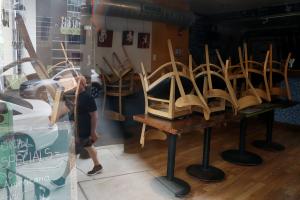Spotlight PA is an independent, nonpartisan newsroom powered by The Philadelphia Inquirer in partnership with the Pittsburgh Post-Gazette and PennLive/Patriot-News. Sign up for our free weekly newsletter.
HARRISBURG — Pennsylvania closed out its fiscal year Tuesday with a $3.2 billion shortfall, with revenues falling 9% below official estimates as the state continues to grapple with the economic damage caused by the coronavirus outbreak.
Since March, when Gov. Tom Wolf announced strict measures to slow the spread of COVID-19, widespread business closures and record job losses have chipped away at the tax revenues Pennsylvania relies on to pay for crucial services.
In June alone, revenues dropped 18% below estimates, with three-quarters of the shortfall attributed to the continued fallout from the virus. The remaining portion is revenue that will be collected in July, after several key tax deadlines were pushed back.
State lawmakers in late May cited the uncertainty around the true economic toll of the outbreak as they passed an unusual stopgap budget, which kept funding in most areas flat for five months. The exception was education, which was funded for a full year.
But, as revenues continue to plummet, legislators will likely face tough decisions come November, when they will hash out a spending plan for the remaining months of the fiscal year.
Although Pennsylvania received almost $4 billion in federal funding under the CARES Act, that money cannot be used to make up for revenue shortfalls under current U.S. Treasury regulations. Given that restriction, lawmakers used some of the money for a $2.6 billion spending plan that offers emergency rent relief, aid to local governments, and grants for small businesses. For now, they are keeping the rest in reserve.
State officials are still hoping that Congress might relax restrictions and allow the money to be used for budget gaps, or send additional, unrestricted aid to states and cities struggling to balance their budgets in the face of dramatic revenue losses.
In May, the state’s Independent Fiscal Office estimated that Pennsylvania will permanently lose $5 billion in revenue through June of next year — assuming there is no need for another wave of business closures.
Recently, however, increases in the number of new cases have threatened to slow the state’s gradual reopening. On Wednesday, Pennsylvania reported the largest one-day increase in cases since the beginning of June.
In response, Wolf announced an order requiring most Pennsylvanians to wear masks in public — including outdoors if they are unable to keep six feet away from other people — and warned that reopening depends on continued vigilance about social distancing. An earlier order required people to wear masks only when they entered businesses.
Philadelphia paused some aspects of its plan for reopening, delaying the start of indoor dining until at least Aug. 1. Officials in Allegheny County ordered bars and restaurants to stop selling alcohol for on-site consumption, after an uptick in cases over the weekend.
100% ESSENTIAL: Spotlight PA relies on funding from foundations and readers like you who are committed to accountability journalism that gets results. If you value this reporting, please give a gift today at spotlightpa.org/donate.
